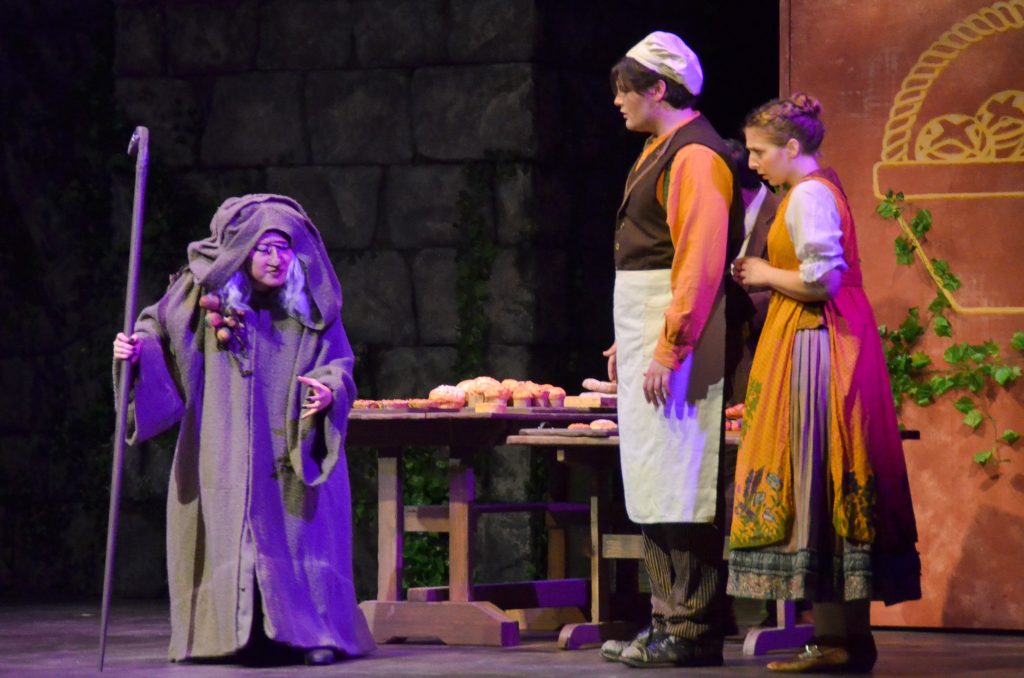“Into The Woods,” a performance by BU’s theatre department, opened at the Watters Theater the past two weeks.
“Into The Woods” is based on a libretto by James Lapine, with score and lyrics by Steven Sondheim. It is a retelling of classic Grimm brothers fairy tales — centered around “Jack and the Beanstalk,” “Rapunzel,” “Cinderella” and “Little Red Riding Hood.” In Act I, Cinderella, Jack, Little Red Riding Hood and the Baker and Baker’s wife are portrayed following orders, making wishes and pursuing their wants. In Act II, characters deal with their lives after their wishes come true. Sondheim and Lapine convey that “Happily Ever After” does not always meet expectations.
Tommy Iafrate, an associate professor and director of musical theater at BU, explained the process behind preparing for “Into The Woods.” Iafrate said the theatre department was looking into the kind of subgenre of the musical theater of which Sondheim is part of, and was left deciding between “Sweeney Todd,” “Sunday in the Park with George” and “Into The Woods.” The theatre department decided to put on “Into The Woods.”
“We ended up going with ‘Into The Woods’ because it offers opportunities for so many different cast members,” Iafrate said. “It’s not the same sort of tent-pole type of production that requires a Sweeney and a Mrs. Lovett and then other characters that are more on the periphery.”
Iafrate said that within the eight years of his employment at BU, this was his first time seeing student designers taking on positions for stage scenery, costumes and lighting.
“It is rare that student designers are ready to design a mainstage musical,” Iafrate said.
Prior to staging rehearsals, Iafrate said the focus was on conducting textual, lyric and character analysis. Iafrate also said there were around two trial runs prior to adding tech.
“We of course start off by learning the music and doing a lot of text analysis and lyric analysis and character analysis,” Iafrate said. “Then we go into staging rehearsals, adding orchestra and costumes and light cues and scene changes and sound cues and everything becomes a totally different show.”
“Into The Woods” explores numerous themes, and Iafrate said it is impossible to say one theme is more important than another. Some main themes included parenting and familial themes, life’s expectations versus reality and individual responsibility versus communal responsibility. Iafrate said the themes relate to modern-day society and compare the characters’ expectations to those held by college students today.
“These characters in Act I follow the rules and they don’t get their happily ever after in the same way that they expected to,” Iafrate said. “We as humans may think all of our problems will be solved once I graduate college or once I get a job, but of course, it’s not easy.”
With regard to individual responsibility versus communal responsibility, Iafrate said the selfish actions made by characters in Act I led to larger problems that must be faced as a community in Act II.
“In Act I, all the characters are pursuing their own personal needs and wants, and then in Act II, they have to deal with the ramifications of that selfishness,” Iafrate said. “The problems are now something that confronts the community as a whole.”
Iafrate compared the obstacles faced by the community of fairytale members to challenges faced around the world today.
“Seeing the way things change when you’re fighting for yourself versus when you’re fighting for your world,” Iafrate said. “That’s something that’s obviously really resonant today as we’re still dealing with how we as a society are or aren’t dealing with [COVID-19].”



